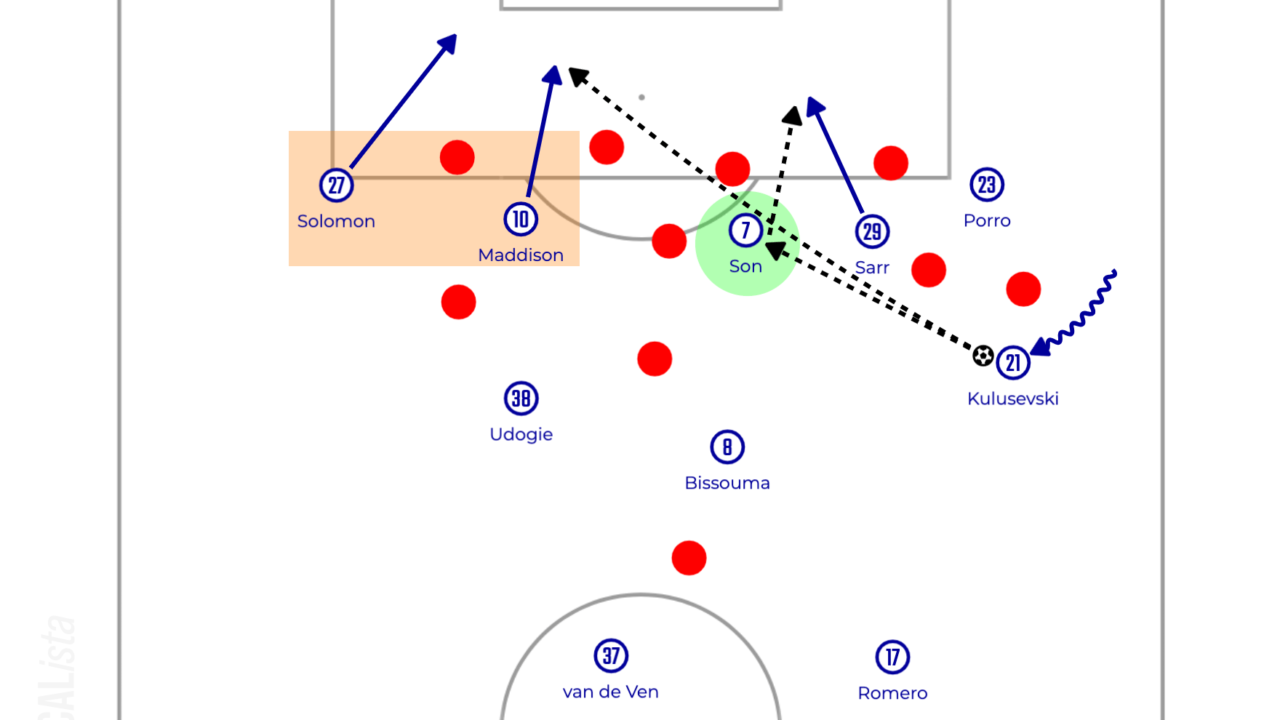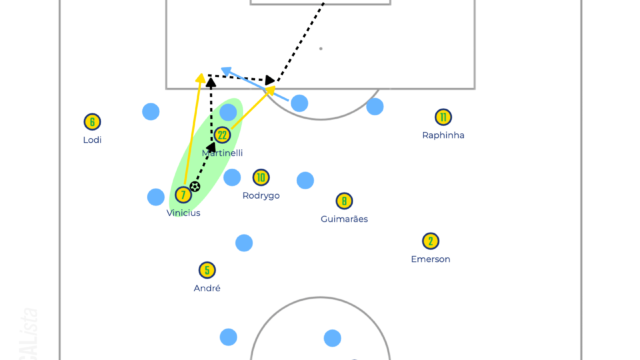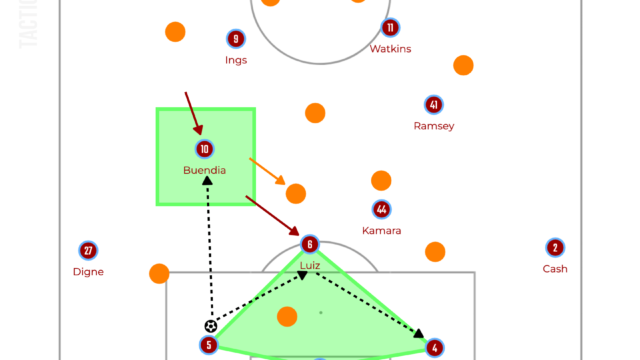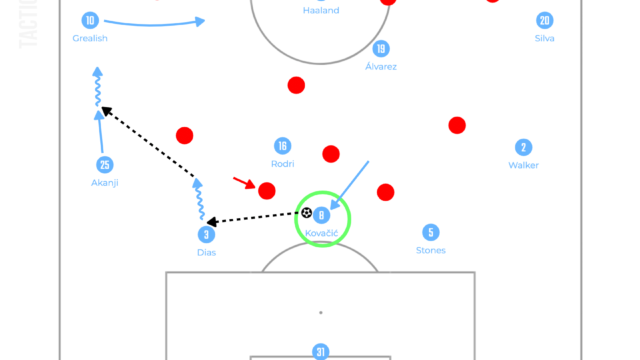Overall
Ange Postecoglou has arrived at English Premier League after winning the treble at Celtic and already surprised many football fans with winning four games in the first five league games and also the quality of his football. His attacking football is so attractive because of its dynamic and effective attacking strategy. The automatic pattern in the final third has already worked well and will be analysed in this article in detail.
Another reason why Spurs has been praised so much is the new signing, James Maddison. There are always good and bad signings in football, but he is one of the greatest singings this season, even though it is still the beginning of the long season. Postecoglou has already found how to maximise his ability in building up and final third and Maddison scored two goals and assisted twice in the first five league games. This indicates how well Spurs are doing well as a club and Postecoglou is definitely the man who can lead this club to the next level with the extreme attacking football which the club has missed for a while.
In this article, his tactics at Spurs are going to be discussed based on the first five league games. I hope you will enjoy this analysis.

Build up
When playing out from the back, one of the main features of Spurs is that the fullbacks come inside as false fullbacks and position themselves extremely narrower. The objective of this would be attracting the opposition forwards and midfielders inside to open the space in wide areas.
The shape can be described as a 2-3-5 plus the goalkeeper at the back with the false fullbacks. It is double pivots out of possession, but Yves Bissouma plays as the single pivot and Pape Matar Sarr steps up into the right pocket. Both wingers keep the width to pin the opposition fullbacks or wingbacks and Maddison occupies the left pocket.

As it is illustrated above, thanks to the positions of both fullbacks and wingers, there is open space in each flank, where the attacking midfielders Maddison and Sarr drift to receive the ball. The opposition fullbacks are pinned by the wingers, so it is difficult for the ball side fullback to jump and press on the attacking midfielder receiving the ball in the flank. In case when the opposition fullback tries to step up but is late to apply pressure on the ball, the attacking midfielder can play in behind by mainly using the fullback inside as a third man, which happened in the game against Manchester United in less than a minute.

This was caused by the disorganised pressing by Man United, but the concept of attracting the opposition players in the middle and exploiting the wide area can be found in this actual example. If the opposition team presses like this, Spurs try to exploit the space in behind quickly, but most teams decide to drop back into the midfield as soon as one of the attacking midfielders receives the ball in a wide area. Overall, it is possible to say that Postecoglou uses the flanks, which are created by the positions of the fullbacks and wingers, as the destinations of building up from the back to escape from the opposition pressure.
In addition to the areas, a player who has a great skill on the ball to dictate the direction or tempo of play can also be the destination, and it is Maddison. He can not only drift outside but also often drop into the middle to receive the ball next to Bissouma from one of the centre backs or goalkeeper.

He has an ability to turn forwards quickly and possess the ball in front of the opposition player, which enables to force the opponent to hesitate to press on the ball. Thanks to his skill to keep the ball under the pressure and also the overload against the opposition first line, finding him is a reasonable option for them to slow the opposition pressure down and force them to drop back into the midfield.
Additionally, he can play a direct ball in behind if he can receive the ball in between the lines. Therefore, his presence in the middle lane is extremely important for Spurs to play out from the back against the opposition pressing and also exploit the space in behind the opposition back line.
So far, the structure with false fullbacks looks so perfect, but one of the disadvantages to use false fullbacks is a lack of fullbacks’ skill to play in the middle. Most fullbacks are used to playing in wide areas where they can only be pressed from the front of them. However, to play in the middle, it is required to play under pressure from everywhere. This can be a problem because Postecoglou plays original fullbacks as false fullbacks, not original midfielders like Oleksandr Zinchenko or Joshua Kimmich under Pep Guardiola.
The answer is there is no problem so far because the fullbacks do not receive the ball so much and are mainly required to position themselves inside as dummies to drag the opposition midfielders inside. When playing out from the back, the centre backs, goalkeeper and Bissouma are the main players to keep the ball at the back. They keep the ball in the middle lane to attract the opposition players in the middle and the centre backs try to play to the attacking midfielders drifting outside. Of course, the fullbacks can receive the ball if there are no immediate pressure on them, but it seems that they want to keep the ball centrally and use the fullbacks mainly as dummies. This is the reason why they do not need to care about their skills on the ball so much.
Final Third Attacking
In the final third of the pitch, their automatic movements in wide areas are so effective and has worked well so far. The basic shape is the same 2-3-5, but because of the flexibility in the final third, the fullbacks and the attacking midfielders often swap the positions each other.
It all starts from the pass to one of the wingers who prefer to dribble inside rather than going forwards. Manor Solomon and Dejan Kulusevski are often positioned themselves in the opposite side of their preferred foot, although Ivan Perišić and Son Heung-min can use both feet freely. This is one of the keys of their rotations in wide areas. As soon as a winger receives the ball, the closest player next to him makes a run in behind through a channel. This can give two options for the winger to play though or dribble inside.

In addition to this initial movement, the other player in the flank offers a passing lane for the winger to play horizontally as well as the option which the winger dribbles inside. This ensures to keep offering the winger at least two options in the wide area.

Even though the winger cannot play to the teammate and is forced to keep dribbling inside, the striker shows up as the fourth player to link up and creates an option to play towards the goal. At the same time, the opposite side attacking midfielder and winger make a diagonal run towards the goal to be target players of the in-swing cross from the winger.

The process is so automatic, but really effective because the rotation enables the winger on the ball to keep having the options to play towards the goal. The first one is playing through the back line to the player making a run into the channel, the second one is passing inside to the player offering a passing lane next to him, the third one is finding the striker and the last one is delivering an in-swing cross into the back post area.
Their strength is that the rotation in wide areas is not isolated and connected with the striker in the middle and the opposite side players. It is common to see teams using wide triangles, but Postecoglou’s side has a plan how to keep playing towards the goal even after the triangle in wide areas is defended well.
Pressing
Postecoglou’s attacking football is not only about in possession. They seamlessly start to press as soon as losing the ball and chase it even towards the opposition goalkeeper. Their willingness to sprint in transitions and the intensity of pressing is one of the greatest in Premier League. Let’s start to discuss their pressing tactics in detail.
The shape is a 4-4-2 with Maddison stepping up into the first line and the pressing starts from the first pass from the goalkeeper.

To prevent more options around the ball and keep applying pressure on around the ball, when one of the strikers applies pressure on the opposition goalkeeper or one of the centre backs, the other striker prefers to mark the opposition centre back rather than screening a passing lane to play through. Instead of the strikers, one of the defensive midfielders, often Sarr steps up to mark one of them. This will leave the space in the middle of the shape, so both wingers tend to be initially positioned narrower to cover the space which Sarr leaves in the middle.

By marking the opposition centre backs and defensive midfielders tightly and thanks to the narrow positions of the wingers, it is possible to force the opponent to play outside, which is the trigger for the winger to jump to apply pressure. Then, the ball side fullback and the defensive midfielder tightly mark the opposition players around the ball to win the ball.
The weakness is that when the press of the winger and fullback delays or the defensive midfielder cannot arrive at the ball side on time, the opposition can play through the middle. This is the problem which the intensity matters. So far, they managed to keep the high intensity throughout the game, but the season is so long, and it can be a key for them to keep being aggressive out of possession as long as possible.
Final Third Defending
In the final third, they focus on not only defending the goal but also pushing the team up to keep the ball away from the goal. This is also Postecoglou’s aggressiveness out of possession. They keep the compactness of the shape and the back line constantly pushes the line up as soon as the opposition plays back. This means there is an exploitable space for the opposition, so many teams often try to clip the ball in behind to create goal scoring chances.
Additionally, when the opposition team plays long in behind, the back line is forced to sprint back towards the goal. However, the defensive midfielders often delay coming back, which means there is a gap between the back line and midfield line. This long ball situation often occurs when pressing high against the opposition throw ins.

Moreover, one of the defensive midfielders tends to cover the space in the channel, so there is only a defensive midfielder to protect the space in front of the back line. Therefore, even though one of them can drop back, no one can deal with cut backs if the other defensive midfielder delays.
This weakness is caused by their aggressiveness out of possession. Therefore, if they successfully push the team up, there are no problems. High risk, but high reward, this is the motto of Postecoglou’s football.
Thank you for reading. I hope you enjoyed this article.




